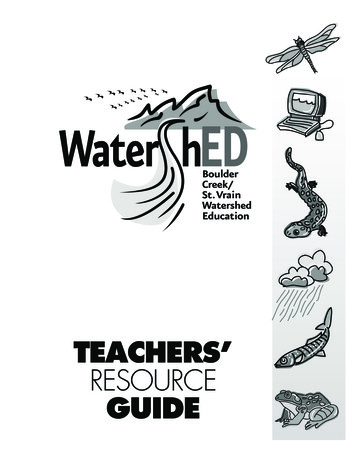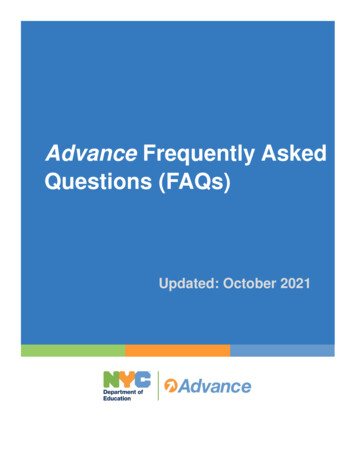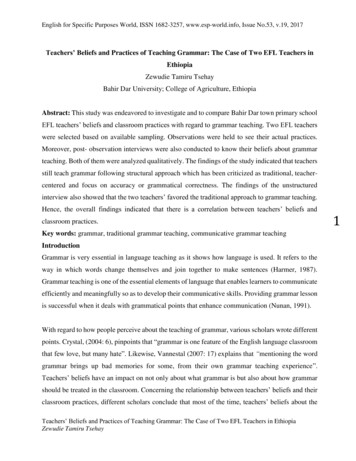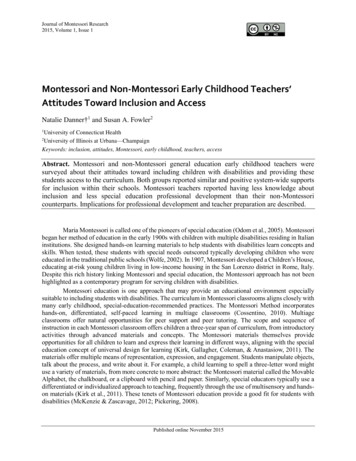
Transcription
BoulderCreek/St. VrainWatershedEducationTEACHERS’RESOURCEGUIDE
TABLEOFCONTENTSBOULDER CREEK/ST. VRAIN WATERSHED EDUCATIONNo.Activity Title1.11.21.31.41.51.6Introducing the Boulder Creek/St. Vrain watershedsWater, Colorado’s Precious ResourceThe Water CycleThe Boulder Water StoryWater Law and SupplyWater ConservationWater Bingo—An Assessment2.12.22.32.42.52.62.7StreamTeams—An IntroductionMapping Your WatershedAdopt-A-WaterwayEnvironmental Networks on the webWatershed WalkWaterway Clean-up: A Treasure HuntStorm Drain Marking3.13.23.3Assessing Your Waterway: Water Quality, a Snapshot in TimeNutrients: Building Ecosystems in a BottleAssessing Your Waterway: Macroinvertebrates –Long-Term Ecosystem HealthStream Gauging: A Study of Flow3.4AppendicesA.B.C.D.E.GlossaryNative Species ListReferences: People and BooksTeacher Evaluation FormPre-Post Student AssessmentWatershE DTa b l e o fContents2
WatershED: your guide to finding out about the place you liveWatershED: your guide to becoming a steward of your water resourcesWatershED:BoulderCreek/St. VrainWatershedEducationyour guide to local participation and actionTHIS GUIDE WILL HELP YOU . . . . get to know your Watershed Address—where you live as defined by creeks, wetlands and lakesdiscover the plants, animals, and birds you might see in or around the creek orwetland in your neighborhoodorganize a StreamTeam to protect and enhance a nearby waterwayWatershED is a resource guide for teachers and students.It provides you with theinformation needed to learn more about the creek or wetland near your school. Itgives suggestions for what your class can do to preserve and protect that waterway.WatershED is an Earth systems science approach to learning about interconnectednessof the water, ecology, geology, meteorology, human influence, and other physical andchemical interactions in our local Boulder County region. Teachers are encouraged totake an interdisciplinary “team teaching” approach when they are teaching about ourlocal environment using the activities contained in this curriculum guide. Because ofthe interdisciplinary nature of this curriculum, listed below are brief summaries of howother content areas of the Colorado Model Content Standards are applied in this curriculum. Colorado Model Content Standards for science are provided at the beginningof each activity.Geography: Students will use and construct maps to locate and derive informationabout their local watershed. Students will gain a sense of place with respect to human,physical, and natural characteristics. Students will observe patterns and change of physical processes that shape the Earth.Mathematics: Students will use data collection and analysis to understand variousinteractions within their local watershed. Students will analyze stream flows, biologicalmeasurements, water use, water quality, and population interactions.Reading, Writing, and Languages: Students will journal, create informational stormdrain marking flyers, and conduct research on their local watershed. All activities maybe taught with additional reading and writing components that may include community presentations, production of newsletters, etc. All activities may be taught in foreignlanguages and evaluate watersheds in other countries as an extension to these activities.WatershE DIntroduction3
History: Students will understand how science, technology, and economic activitiesaffect local watershed history.Civics: Students will understand the purpose for local government interaction and therole of citizen participation in watershed protection.Economics: Students will understand the condition of scarcity when evaluating droughtconditions and the need for water conservation practices. Students will understand theeconomic aspects of using natural resources.Visual Arts: Students will build watershed models, make flyers, and draw observationsof their local watershed.ACKNOWLEDGMENTSThis watershed resource guide was made possible by grants from the Denver UrbanResources Partnership Office and the Bureau of Reclamation. The primary authors onthe guide were City of Boulder WASH Education Outreach Coordinator, TammiLaninga, and Boulder Creek Watershed Initiative President, Jeff Writer. We would liketo thank the Boulder Valley School District teachers who reviewed the guide and piloted many of the activities: Holly Cunningham, Whittier Elementary; Emily Weller, BearCreek Elementary; Nadyne Orloff, Halcyon School; Dan Tomlin, Burbank MiddleSchool; and Jeff Writer, Centaurus High School.2004 revisions provided by WASH Education staff.WASHA partnership of communities in theBoulder and Saint Vrain watersheds workingtogether to protect our water quality.BOULDER COUNTY CITY OF BOULDER CITY OF LONGMONTCITY OF LOUISVILLE TOWN OF ERIE TOWN OF SUPERIORWatershE DIntroduction4
THEBOULDER CREEK/ST.VRAINWATERSHEDSEveryone lives or a watershed, and most of us live near a river or stream. We live in theBoulder Creek St. Vrain Watersheds. Learning about our watershed will give us thenecessary tools needed to ensure the protection of this incredible water resource.A watershed is an area of land that drains into a stream or lake. Watersheds range insize from an area drained by a small alpine spring to a large river system such as theMississippi, which drains the entire central portion of the United States.BOULDERCREEK/ST. VRAINWATERSHEDMAPBoulder County lies within the St. Vrain watershed, which is part of the larger SouthPlatte River Basin, which is nested within the Missouri/Mississippi River basins. Thebasin is bordered on the west by the Continental Divide between Longs Peak and JamesPeak. The headwater tributaries provide a significant portion of the drinking water supply for those living in the basin. Boulder County accounts for 75% of the 993 squaremile area, with the remainder extending into portions of Gilpin, Jefferson, Adams andWeld counties. The 440-square-mile Boulder Creek/St. Vrain watershed is the major"sub" basin within the St. Vrain watershed. The basin is a complex natural systemwhich has specific needs to remain in balance.The watershed supports trout in the higher stream reaches and warm water fish such asbass and sunfish in the lower reaches. An abundant number of aquatic insects and waterfowl can also be found in and around the many creeks of the watershed. Boulder CreekWatershE DBoulder CreekWa t e r s h e d5
and it many tributaries also provide a number of valued uses for the community suchas water for irrigation and drinking, recreation, flood control, and hydropower.The cities of Nederland, Boulder, Louisville, Lafayette and Superior are the largest citiesin the watershed. According to the 2000 census, over 291,000 people were living inBoulder County. That number is expected to increase 15% to bring the total population to 335,000 by 2010. As population in the basin grows, development and the associated water quality impacts will also increase.Human impacts to the Boulder Creek/St. Vrain Watersheds are many and varied.Historical mining activity in the upper reaches of these watershed introduced metalcontaminants into creeks. More recent impacts to our waterways include buildingreservoirs for water supply and hydropower; straightening and channeling steams forflood protection; developing towns and cities along the primary waterways; and takingwater for irrigated agriculture. The combined results of these uses have been thereduction of stream side vegetation; degradation of water quality from agriculture andurban pollution; loss of native aquatic species; and a general degradation of aquaticand riparian ecosystems.The job of preserving our larger rivers, reservoirs and aquifers is a task for local, state,and national organizations. By protecting our smaller streams and restoring localwatersheds we can each be a part of the solution. Since every one of use lives in awatershed, each of us directly affects the health of a nearby creek. Everyone can helprestore, protect or enhance a stream at the local level. By monitoring streams that flowby our schools and homes, we can get an idea of the activities going on in the watershed upland from us. And we can make sure that we ourselves are not degrading waterfor the people who live downstream. You can do this by organizing a StreamTeam inyour classroom. Your StreamTeam can adopt a stream to protect and enhance. Thebest way to learn about the creek near your school is to jump in!WatershE DBoulder CreekWa t e r s h e d6
ECOLOGYANDECOSYSTEMSWHAT IS ECOLOGY?Ecology is the scientific study of how living things interact with each other and theirenvironment. Ecological interactions take place and can be studied scientifically in allenvironments, including cities and suburbs.ECOLOGICAL CONCEPTSInterdependence of living and nonliving “elements”: Interdependence means that eachelement is somewhat, if not totally dependent on the other for its ability to function.Ecosystems: Ecosystems are groups of living and nonliving things that functiontogether in a particular environment. For example, prairie dogs, birds, insects, lowlying grasses, and shrubs (living elements) interact with each other as well as with drysoil, high winds, and occasional downpours (nonliving elements) to make up theshortgrass prairie ecosystem.Community: All the organisms that live together in an ecosystem comprise a community. In the above example, prairie dogs, birds, insects, grasses, and shrubs make upthe shortgrass prairie community.Habitat: Good habitat has four essential components—food, water, shelter, and space.Each species has different requirements for the types and amounts of each habitatcomponent. Five common urban habitats include: the urban edge, the inner city, thebackyard, the riparian corridor, and the park and open space. In the Front Range,there are countless habitat types and more than 350 common species of wildlife thatexist in this area.Source: Moorhead, Carol Ann. Colorado Backyard Wildlife. Roberts Rhinehart Publishers 1992. pages 25-32.WHAT IS AN ECOSYSTEM?Ecosystems encompass all the parts of a certain environment, including the living(biotic) plants and animals, and the nonliving (abiotic) components, such as soil,water, air, and the sun’s energy. Ecosystems transition into another one with little changeor distinction; for example, it is hard to tell exactly where a stream turns into a river.Every ecosystem contains species of plants and animals. Each species occupies its ownecological niche or role that it fulfills in the environment. Ecosystems found in theBoulder Creek/St. Vrain Watershed include plains grasslands, mountain grassland andmeadows, lowland riparian, mountain riparian, ponderosa pine forest, aspen groves,lodgepole pine forests, alpine tundra and the aquatic ecosystem. The focus of this section will be the lowland and mountain riparian zones and the aquatic ecosystem.WatershE DEcology &Ecosystems7
Species ofLowlandRiparianEcosystems(refer to appendix for full listing of species)Treesgreen ash, plains cottonwood, peach-leaved willowShrubshawthorn, wild rose, wildplum, sandbar willowHerbaceous Plantsbroad-leaved cat-tail, poison ivy, saltgrass, sunflowers, bulrushBirdsgeese, ducks, grebes,herons, egrets, gulls, owls,hawks, dippers, warblers,flycatchers, jays, wrens,woodpeckers, belted kingfisherReptiles &Amphibianstiger salamander, woodhouse’s toad, western chorus toad, bullfrog, snapping turtle, short-hornedlizard, western rattlesnake,smooth green snake,northern water snake, bullsnake, common garterWatershE DEcology &Ecosystems8LOWLAND RIPARIAN ECOSYSTEMSLowland riparian ecosystems are found along banks of rivers, streams and other bodies of water and include floodplain woodlands and marshes. They are narrow, transitional zones between aquatic and terrestrial ecosystems with distinct vegetation andsoils. Before the development of Boulder County, the only deciduous trees in theBoulder Creek/St. Vrain Watersheds where found in the riparian ecosystem.Trees and other vegetation help to moderate intense winds and sunlight in this ecosystem. Often soils are young and moist, with a high water table and poor drainage dueto continuous changes in water flow (drought or flood) or erosion.Lowland river bottoms and marshes are the most productive natural ecosystems in theregion—for plants and wildlife. Many animals live in or near the riparian zonebecause of the lush forage, water, and abundant denning or nesting sites. Riparianzones also offer a refuge to animals that live in other ecosystems. Many bird, reptiles,amphibians and small mammals make their homes in the riparian ecosystem.Humans have used and affected the lowland riparian and wetland ecosystems.Impacts to these ecosystems include mining gravel along stream banks, cutting cottonwoods for firewood and lumber, building housing developments in the flood plain,grazing cattle, and artificially channeling and damming waterways for flood protection and water supplies.MOUNTAIN RIPARIAN ECOSYSTEMSMountain riparian ecosystems are found adjacent to streams, ponds and lakes. Smallmeadows dominated by deciduous trees and moisture-loving shrubs form this ecosystem. High mountain streambanks and wetlands support a diverse array of plant communities that provide food and cover for many animal species.Mountain riparian ecosystems are found throughout forested mountains (5600 to11,000 feet). Since streams run through the mountains at all altitudes, riparian ecosystems form continuous strands that cross the subalpine and montane forests. At theirupper edges the ecosystems pass through tundra marshes; they merge with lowlandriparian ecosystems at their lower limits.Riparian ecosystems in mountain and subalpine regions have fewer species than atlower elevations, but diversity is still high compared to most adjacent ecosystems.They provide abundant food and cover for a variety of birds and animals.Mountain riparian ecosystems have been greatly altered by human use. Some of theimpacts in this ecosystem include removal of beavers to create hay meadows and cattle grazing, building transportation routes adjacent to streams, mining peat bogs,housing developments, and mining of minerals found in the mountains. Many aquatic reaches have been stained yellow or orange with mineral deposits and are devoid ofinsects and fish. This activity has not directly impacted the mountain riparian ecosystem but has also impacted ecosystems downstream.
AQUATIC ECOSYSTEMAquatic ecosystems are streams, rivers, ponds, lakes and reservoirs. In these ecosystems, the distribution of organisms is determined by water temperature, clarity, current, the amount and kind of dissolved materials, and the types of materials that linethe stream or lake bottom.Characteristics of streams, and thus plant and animal habitats, change with elevationas the streams flow from the mountains to lower elevations. At the highest reaches, thewater is cold and almost as pure as distilled water; stream beds are steep and strewnwith boulders; and dissolved oxygen levels are high because of the cascading water andcold temperatures. Few aquatic plants can survive the cold, swift moving, nutrientpoor waters of the highest streams. In these places the major energy source is organic detritus (leaves, twigs) which serve as food for microbes, aquatic insects and othersmall organisms.At middle elevations, stream channels are not as steep and the stream bed has bothboulders and rocks. Mid-elevation streams alternate between deep, quiet pools andriffles: shallower areas with a steeper slope, faster current, and a bed of large, cobblesized rocks. Pools and riffles each provide a unique habitat to stream inhabitants. Atmiddle elevations, where currents lessen and more phosphorous, nitrogen and otherplant nutrient are available in the water, a coating of periphyton covers the stream bedrocks. This living film is an important food source for insects and other invertebrates.It consists of algae, diatoms, and water moss. Riffles are particularly productive areas,where periphyton-covered rocks support a diverse insect community. Pools accumulate detritus and are important sites for organic decomposition and nutrient recycling.Riffles are important feeding grounds for trout, while pools provide quieter water forthem to rest.At lower elevations, where streams leave the mountains, the gradient declines and currents slow down causing concentrations of dissolved salts to increase, temperatures toincrease, and oxygen content to decrease. Accumulations of suspended particulatesreduce the water’s clarity. At times, streams are extremely turbid, especially duringspring runoff. The sediments of low elevation stream beds are more fine-grained thanin the mountains, and consist of gravel, sand or silt.Healthy riparian ecosystems are of prime importance to aquatic habitats. Riparianvegetation helps hold stream bank soils in place, which in turn reduces the sedimentloads entering them. Riparian lands also contribute organic detritus to streams, whichoften serves as the most important source of energy for aquatic food webs.Streams and rivers are inhabited by a variety of aquatic organisms. The largest organisms are vertebrate animals—fish and a few amphibians and reptiles. The invertebrates—insects, snails, flatworms, leeches, and other small animals without backbones—are far more numerous. There are two types of invertebrates: macroinvertebrates are those that can be seen without a microscope; and microinvertebrates arethose you can see only under a microscope.Stoneflies, mayflies, caddisflies, true flies, and riffle beetles collectively comprise aboutninety percent of the total macroinvertebrate fauna of the Boulder Creek/St. VrainWatersheds stream systems. The most abundant fish found in the higher, coolerSpecies of theMountainRiparianEcosystem(refer to appendix for fulllisting of species)Treesalder, cottonwood,birch, Colorado bluespruce, white fir.BirdsYellow warblers,American goldfinches,will and cordilleran flycatchers, westernwoodpewees, beltedkingfishers, hawks,owls, green-wingedteal, mallards, dipperReptiles &Amphibianstiger salamander, boreal toad, wood frog,striped chorus frog,smooth green snakeMammalswater shrew, muskrat,montane vole, westernjumping mouse,chipmunks, squirrels,rabbits, beaver, moose,river otterActivityLevelWatershE DActivity 1.19
streams of this area include brook, rainbow and brown trout. These species wereintroduced into area streams more than 100 years ago. These exotic fish species havereduced the population of the native cutthroat trout and restricted its populations tothe highest and steepest streams. In the warm water streams of Boulder County, channel catfish, suckers and sunfish are abundant.Aquatic ecosystems are impacted by a broad range of human activities. The ecosystemhas been affected by the following actions: heavy metal pollution from acid minedrainage; dust and oil from roads; pesticides, fertilizers, animal waste from agriculture;industrial wastes; heated water from power plant condensers; and treated and untreated discharges from municipal sewage treatment plants; damming rivers or buildingtransbasin water diversions for drinking water supply and irrigation; and introducingnon-native fish species for sport fishing.Human modifications have reduced the number of destructive floods, increased thenumber of fish species, and provided water to relatively dry places. However, in returnwe have decreased the number of free-flowing streams and health aquatic ecosystemsto the point that they have become as endangered as the rare species within them.Source: Mutel, Cornelia Fleischer and John C. Emerick. From Grassland to Glacier: theNatural History of Colorado and the Surrounding Region. Johnson Publishing 1992.pages 59-70; 71-85; 205- 226.ActivityLevelWatershE DActivity 1.110
WATERQUALITYBoulder Creek and St. Vrain Rivers begin in the Rocky Mountains west of the foothills.Those creeks flow through the mountains and canyons toward Boulder County communities, picks up pollution particulates from the air, travels past old mines, andthrough some agricultural and residential areas. When these streams reach Boulderand Longmont, the y flow through the middle of town. Here they are subject to thestrains of the city: automobile oil, paint, fertilizers, treated wastewater effluent, foodwastes, trash, etc. The creeks eventually meander into eastern Boulder County wherethey traverses farms and new rural subdivisions. On their journey from the highmountains to their convergence with the St. Vrain River, Boulder and St. Vrain Creeksare influenced by every type of urban and rural impact.The health of a stream can be monitored with physical, chemical and biological parameters. The primary physical and chemical parameters include turbidity and color,temperature, flow, dissolved oxygen, pH, and chemical pollutants such as heavy metals, nitrate, and phosphate.COLOR AND CLARITYWe can learn a lot about a stream by its color and clarity. Rainwater, groundwater andsnowmelt run clear unless a stream’s banks are eroding. Glacial meltwater, on the otherhand, appears milky gray from “glacial flour,” tiny suspended particles of rock crushed bythe grinding force of moving glaciers. Brown water might be a sign of a mudslide in themountains, a heavy storm event, or local erosion. Greenish water may represent bloomsof algae nourished by excess fertilizers from yards, golf courses, or farms. “Suds” mightpoint to detergents or to septic tank failure. An iridescent sheen on the water may havebeen released from rotting leaves; however it could mean that used motor oil or oil-basedpesticides leaked or were dumped into the stream, or perhaps it was picked up in runofffrom roads, driveways, and parking lots. To test the clarity of a creek, turbidity measuresare taken. Turbidity is defined as the light scattering capability of a particle. In naturalwaters, it may be caused by algae or by organic acids, which stain the water a dark brown.But it usually indicates suspended sediments—fine soil particles, held in suspension bythe turbulence of the current—which scatter light passing through the water. Excess sediment reduces the clarity of water and it can harm the gills of fish and aquatic insects. Italso makes it more difficult for aquatic species to find food and escape predators.TEMPERATUREWater temperature is another easy test that tells a lot about a waterway. Temperaturedetermines where aquatic organisms can live. Plants and animals that live in the creekare completely surrounded by water, and so their “climate” depends on water temperature rather than air temperature. In fact, since fish and aquatic insects are “coldblooded,” they become the temperature of the water. Their metabolism, growth rate,and all internal chemical reactions are regulated by the water temperature. Theamount of oxygen found in a waterway is directly connected to the temperature.Cooler water holds more dissolved oxygen than warmer water. Different aquaticspecies have found their habitat in streams according to food availability, oxygen needsand temperature. Trout like cold, oxygen-rich waters, whereas bass and sunfish preferto live in warmer water.WatershE DEcology &Ecosystems11
CURRENT AND FLOWCurrent and flow are also easy characteristics to monitor. Activity 3.4 provides directions for taking flow on your waterway. Current is determined in part by the gradient,or slope, of the stream. Mountainous headwaters have swift currents because they dropquickly over a short reach. Current also varies with the flow, which is the amount ofwater carried by the stream channel at any given time. Water levels fluctuate throughout the year. During the spring, the creeks in the Front Range rise quickly and have swiftcurrents because of melting snow in the mountains. By midsummer, when most of thesnow has melted and the hot, dry weather sets in, creeks slow down and sometime evendry up. Creeks may rise for a short time during the summer if a heavy thunderstormreleases a lot of rain over the headwaters of a creek. During fall and winter, watershedcreeks maintain a fairly slow, constant flow, as rain and snow contribute more consistentwater to the creeks. During normal flow, currents are controlled by instream structures,both natural and human-made. Large boulders, fallen trees, and beaver dams are examples of natural current checks. On a larger scale, hydroelectric, irrigation and flood-control dams also check the current. Knowing the flow and current of a stream helps usknow how quickly something, such as a pollutant, might travel down a creek. We canalso determine the types of animals that live in the creek depending on the site.DISSOLVED OXYGEN (D.O.)Some important stream measurements are not as visible as the first ones mentioned.There are certain things that need to be measured with sampling equipment, such asthe levels of dissolved oxygen in a stream.Instream creatures depend on oxygen that is dissolved in the stream water. Still orslow-moving water gets some oxygen from the air above it. In a pond, for example,only the upper layers receive much dissolved oxygen, while the bottom layers are oftendepleted by the respiration of animals in the mud and by bacteria decomposition.Rushing water, as it churns over rocks and plunges over hundreds of tiny falls, is aerated by the bubbles of air that get caught by the water. Plants add oxygen to the waterduring daylight as a byproduct of photosynthesis, but they also deplete it as theyrespire a night. Water never contains large amounts of oxygen: our atmosphere contains 23% oxygen, whereas even oxygen-saturated water has less than 1%. Small losses or gains in D.O. levels can be critical to instream species.The amount of D.O. in a stream is dependent on three things: water temperature, theamount of oxygen taken out of the water by respiring and decaying organisms, and theamount put back by physical aeration and photosynthesis. The cooler the water is, themore dissolved oxygen it can hold. Large active fish like trout, which need a lot of oxygen, are restricted to cool streams.WatershE DEcology &Ecosystems12pHpH is another invisible, yet very important parameter to measure. pH is the amountof hydrogen ions in the water (p stands for “negative logarithm of ”; H for hydrogenions). The lower the number, the higher the acidity. The pH scale goes from 1-14. pH
7 is neutral (distilled water); pH 2 is acidic (vinegar); pH 13 is basic (ammonia). pHaffects the solubility of many nutritive and toxic chemicals in the water and thus theiravailability to stream creatures. Alkalinity—the opposite of acidity—is a measure orthe stream’s capacity to buffer, or neutralize, the effects of acidity.CHEMICAL POLLUTANTSA final test to measure a stream’s health is to monitor for chemical and heavy metal pollutants. Some pollutants, not soluble in water, can be easily detected. Petroleum products spread over the surface of water creating a rainbow sheen. Other chemicals mayhave volatile gasses that can be detected by smell. And some, like detergents, give a slippery feeling to the water or create suds on the surface. Unfortunately, most chemicalsdissolve in water and cannot be detected except by expensive laboratory instruments.The only way we “see” them is by noting their effects on stream life—organisms sensitive to chemicals may die out while more tolerant ones thrive.Major chemical spills will cause dramatic plant and animal deaths throughout theimpacted stream. However, most waterways are slowly degraded over a period ofmonths or years. Certain chemicals and metals are tested regularly because of theireffects on the aquatic ecosystem and their potential danger to humans. Lead is tested inour drinking water because its compounds are poisonous and accumulate in the bonestructure. Lead is seldom found in surface waters because it is precipitated by a varietyof substances. Nitrate and phosphate are two chemicals tested for because they arenutrients. High levels of nitrates and phosphates can lead to the excessive growth ofaquatic plants. High levels in natural water supplies may indicate some nonpoint sourcepollution problems such as fertilizer runoff from lawn or fields.One other constituent often tested for is the fecal coliform bacteria. It is important tofind out if our water sources are being polluted by septic tank or agricultural runoff. Iffecal coliform is detected in a waterway, it means that certain disease causing pathogensare present. These pathogens can cause great harm to both aquatic species and humans.STREAM INSECTSBenthic (creekbottom) macroinvertebrates, or stream insects are an important featureof the stream ecosystem. Stream insects are monitored to check the overall health ofthe stream. This bioassessment is conducted for a number of reasons:1) macroinvertebrate communities have limited migration patterns, thus they aregood indicators of localized conditions;2) they integrate the effects of different pollutants and other short-term environmental variations, thus providing a holistic measure of the impact of various contaminants; and3) as a primary food source, they are important to the overall health of the streamecosystem.As you can see, the creek ecosystem is dependent on many things working together tomaintain a healthy balance —clarity, temperature, current and flow, dissolved oxygen,pH and chemicals. To make sure our waterways are protected, these parametersshould be monitored regularly.Source: Yates, Steve. Adopting a Stream: A Northwest Handbook. Published by The Adopt-A- Stream Foundation. 1988.WatershE DEcology &Ecosystems13
STORMWATERQUALITYBACKGROUNDStormwater runoff occurs when precipitation from rain or snowmelt flows over theground. Impervious surfaces like driveways, sidewalks, and streets prevent stormwaterfrom naturally soaking into the ground. Stormwater can pick up debris, chemical
1.1 Water, Colorado's Precious Resource 1.2 The Water Cycle 1.3 The Boulder Water Story 1.4 Water Law and Supply 1.5 Water Conservation 1.6 Water Bingo—An Assessment 2.1 StreamTeams—An Introduction 2.2 Mapping Your Watershed 2.3 Adopt-A-Waterway 2.4 Environmental Networks on the web 2.5 Watershed Walk 2.6 Waterway Clean-up: A Treasure Hunt











